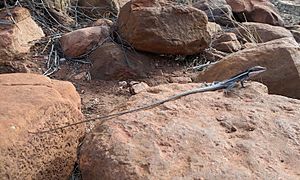Long-snouted lashtail facts for kids
Quick facts for kids Long-snouted lashtail |
|
|---|---|
 |
|
| Conservation status | |
| Scientific classification | |
| Genus: |
Gowidon
|
| Species: |
longirostris
|
| Synonyms | |
|
|
The Gowidon is a type of lizard that lives in trees. It belongs to the family called Agamidae. There is only one known species in this group, which is called Gowidon longirostris. You might know it better by its common names: the long-snouted lashtail or the long-nosed water dragon. These lizards live in different parts of Australia, including the Northern Territory, Queensland, South Australia, and Western Australia. They can also be found in New Guinea.
Contents
What is a Long-Snouted Lashtail?
The long-snouted lashtail is a fascinating lizard. It gets its name from its long, pointed snout. This special nose helps it hunt for food. These lizards are known for being very quick and agile. They can move easily through trees and bushes.
Appearance of the Lashtail
This lizard has a slender body. It can grow to a medium size, usually around 20 to 30 centimeters long, including its tail. Their skin often has shades of brown or grey. This helps them blend in with their surroundings. They might also have patterns or stripes on their bodies. Their long tail helps them balance when climbing. It also acts like a whip to help them move quickly.
Where Do They Live?
Long-snouted lashtails prefer to live in areas with lots of trees. They are often found near water sources like rivers or creeks. This is why they are sometimes called "water dragons." They enjoy warm climates. You can spot them in tropical and subtropical regions. They spend most of their time in trees. They use the branches for basking in the sun and for hunting.
What Do They Eat?
These lizards are carnivores, which means they eat meat. Their diet mainly consists of insects. They love to munch on crickets, grasshoppers, and beetles. Sometimes, they might also eat other small invertebrates. They are active hunters. They use their sharp eyesight to spot prey. Then, they quickly pounce to catch their meal.
Life and Behavior
Long-snouted lashtails are mostly active during the day. This means they are diurnal. They spend their mornings basking in the sun. This helps them warm up their bodies. After warming up, they start looking for food. They are very good at climbing. They can cling to tree trunks and branches. They are also quite shy. If they feel threatened, they will quickly hide.
Reproduction and Life Cycle
Like many lizards, long-snouted lashtails reproduce by laying eggs. The female lizard will dig a nest in the ground. She then lays her eggs there. The eggs are usually buried in soft soil. This keeps them safe and warm. After a period of time, the baby lizards hatch from the eggs. They are tiny versions of their parents. They must learn to hunt and survive on their own.
Conservation Status
The Gowidon longirostris is currently listed as "Least Concern" by the International Union for Conservation of Nature (IUCN). This means that their populations are stable. They are not considered to be at high risk of extinction. However, it is always important to protect their habitats. This ensures they continue to thrive in the wild.


